Mathematics - Algebra of Vectors | 11th Mathematics : UNIT 8 : Vector Algebra I
Chapter: 11th Mathematics : UNIT 8 : Vector Algebra I
Algebra of Vectors
Algebra of Vectors
We have studied basic algebraic operations on real numbers and on matrices. Similarly we studied some operations on vectors. Now let us see how to add two vectors, subtract a vector from another vector and multiply a vector by a scalar.
1. Addition of Vectors
Let us define the sum of two vectors in two ways and see that they are the same. Let us assume that an object of unit mass is placed at the origin (0,0) in R2. We assume that the size of the object is just a point. Let us assume that two forces ![]() and
and ![]() of unit magnitude act on the object in the positive directions of x-axis and y-axis respectively (Fig.8.4). It is easy to guess that the object will move in the direction 45° to the x-axis as indicated in Fig.8.5. The forces
of unit magnitude act on the object in the positive directions of x-axis and y-axis respectively (Fig.8.4). It is easy to guess that the object will move in the direction 45° to the x-axis as indicated in Fig.8.5. The forces ![]() and
and ![]() are equal to the vectors
are equal to the vectors ![]() and
and ![]() b as indicated in Fig. 8.6. We may think that the forces push the object in Fig. 8.4 and pull the object in Fig.8.6.
b as indicated in Fig. 8.6. We may think that the forces push the object in Fig. 8.4 and pull the object in Fig.8.6.
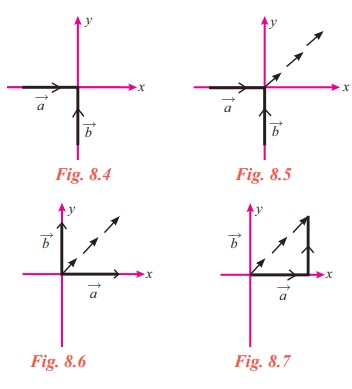
The next question before us is ‘How long will it go?’. Let us assume that the forces act one after the other. The force ![]() will move the object one unit along the x-axis. So the object will move from (0, 0) to (1, 0). Now the force
will move the object one unit along the x-axis. So the object will move from (0, 0) to (1, 0). Now the force ![]() will move the object vertically from (1, 0) to (1, 1). So finally the object will be at (1, 1) (Fig. 8.7). Thus the sum of the two vectors may be defined as the line segment joining (0, 0) and (1, 1) in the direction ‘(0, 0) to (1, 1)’.
will move the object vertically from (1, 0) to (1, 1). So finally the object will be at (1, 1) (Fig. 8.7). Thus the sum of the two vectors may be defined as the line segment joining (0, 0) and (1, 1) in the direction ‘(0, 0) to (1, 1)’.
Now, as in the same situation discussed above, let us assume that the force ![]() has magnitude 2 instead of 1 (Fig. 8.8). It will not be difficult to guess that the object will move in a direction much closure to the x-axis as indicated in Fig. 8.9. Also we may guess that the object will go to the point (2,1). Thus the sum of the two vectors may be defined as the line segment joining (0,0) and (2,1) in the direction “(0,0) to (2,1)”.
has magnitude 2 instead of 1 (Fig. 8.8). It will not be difficult to guess that the object will move in a direction much closure to the x-axis as indicated in Fig. 8.9. Also we may guess that the object will go to the point (2,1). Thus the sum of the two vectors may be defined as the line segment joining (0,0) and (2,1) in the direction “(0,0) to (2,1)”.
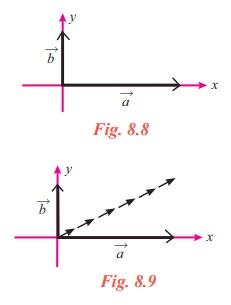
In the two situations discussed above the directions of the forces are perpendicular to each other. This need not be the case in general. Even then we can add the forces by considering one after the other. For example let ![]() and
and ![]() be two forces in a plane as shown in Fig. 8.10.
be two forces in a plane as shown in Fig. 8.10.

Bringing the initial point of ![]() to the terminal point of
to the terminal point of ![]() (Fig. 8.11), we can get the resultant of these two forces (see Fig. 8.12). This motivates us to define the sum of two vectors.
(Fig. 8.11), we can get the resultant of these two forces (see Fig. 8.12). This motivates us to define the sum of two vectors.
Triangle law of addition
Let ![]() and
and ![]() be two vectors. Let A1 and B1 be the initial points of
be two vectors. Let A1 and B1 be the initial points of ![]() and
and ![]() , and A2 and B2 be the terminal points of
, and A2 and B2 be the terminal points of ![]() and
and ![]() respectively.
respectively.

Draw A3 B3 parallel to B1 B2 so that A3 B3 = B1 B2. Then the vector ![]() is defined as the sum of the vectors
is defined as the sum of the vectors ![]() and
and ![]() , and it is denoted as
, and it is denoted as ![]() +
+ ![]() . This can be restated as,
. This can be restated as,
Definition 8.10 (Triangle law of addition)
If two vectors are represented in magnitude and direction by the two sides of a triangle taken in order, then their sum is represented by the third side taken in the reverse order.
Result 8.1
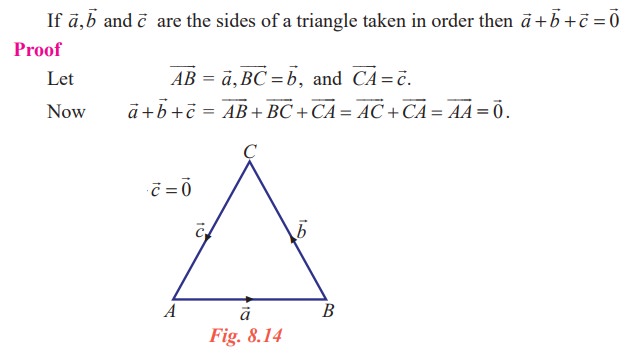
Thus the result is proved.
Parallelogram law of vector addition
Let ![]() and
and ![]() be two vectors. Assuming that the initial points of the two vectors are the same, let us find the sum according to Definition 8.7. Let A and B be the terminal points of
be two vectors. Assuming that the initial points of the two vectors are the same, let us find the sum according to Definition 8.7. Let A and B be the terminal points of ![]() and
and ![]() respectively (Fig. 8.15). To find
respectively (Fig. 8.15). To find ![]() +
+ ![]() , we draw AC parallel to OB so that OB = AC and declare that
, we draw AC parallel to OB so that OB = AC and declare that ![]() is the sum (Fig. 8.16). We observe that OA and BC are parallel (Fig. 8.17).
is the sum (Fig. 8.16). We observe that OA and BC are parallel (Fig. 8.17).
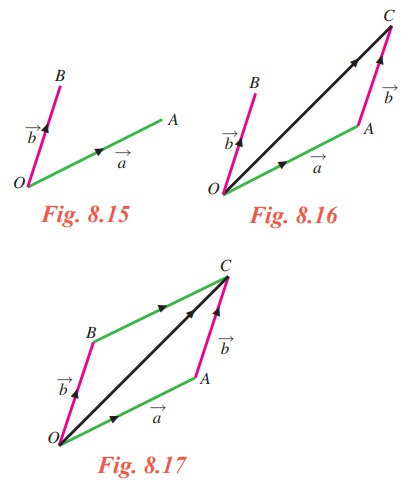
So to find the sum of two vectors with the same initial point, draw the parallelogram with the given vectors as adjacent sides and declare the diagonal as the sum. Even the vectors do not have the same initial point, we can move one of the vectors suitably and make them to have same initial point.
This leads us to the following Definition 8.11.
Let ![]() and
and ![]() be two vectors with the same initial point O. Let A and B be the terminal points of
be two vectors with the same initial point O. Let A and B be the terminal points of ![]() and
and ![]() respectively.
respectively.
Complete the parallelogram OACB. Then the vector ![]() is defined as the sum of the vectors
is defined as the sum of the vectors ![]() and
and ![]() . Thus
. Thus
Definition 8.11 (Parallelogram law of addition)
In a parallelogram OABC if ![]() and
and ![]() represents two adjacent sides, then the diagonal
represents two adjacent sides, then the diagonal ![]() represents their sum (see Fig. 8.17).
represents their sum (see Fig. 8.17).
Though we have two definitions for addition of vectors, they are one and the same. Definition 8.10 is defined using the triangle law for addition of vectors and Definition 8.11 is defined using the parallelogram law for addition of vectors:
In a triangle ABC if ![]() and
and ![]() represent two sides, then the third side
represent two sides, then the third side ![]() represents their sum.
represents their sum.
2. Difference between two Vectors
Now let us see how to subtract one vector from another vector.
Definition 8.12
Let ![]() be a vector. Then the reverse of
be a vector. Then the reverse of ![]() , denoted by −
, denoted by −![]() , is defined as the vector having the magnitude of
, is defined as the vector having the magnitude of ![]() and the direction opposite to the direction of
and the direction opposite to the direction of ![]() .
.
Notice that if ![]() =
= ![]() , then
, then ![]() = −
= −![]() .
.
Geometrical interpretation of difference between two vectors
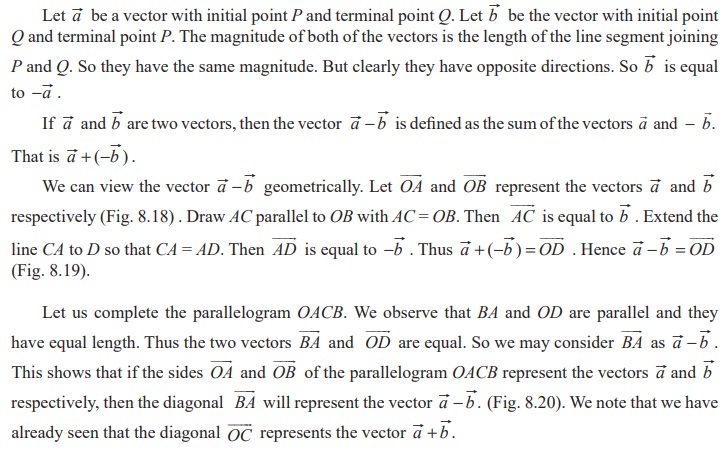
Thus, if ![]() and
and ![]() represent two adjacent sides of a parallelogram then the diagonals represent
represent two adjacent sides of a parallelogram then the diagonals represent ![]() +
+![]() and
and ![]() -
- ![]() .
.
3. Scalar multiplication of a vector
Now let us see how to multiply a vector by a scalar.
Let ![]() be a vector and m be a scalar. Then the vector m
be a vector and m be a scalar. Then the vector m![]() is called the scalar multiple of a vector
is called the scalar multiple of a vector ![]() by the scalar m.
by the scalar m.
Let us note that when m is zero, the magnitude of m ![]() becomes 0 and hence m
becomes 0 and hence m ![]() becomes the zero vector. If m is positive, then both a and m a have the same direction and when m is negative, then
becomes the zero vector. If m is positive, then both a and m a have the same direction and when m is negative, then ![]() and m
and m ![]() have opposite directions. Thus
have opposite directions. Thus ![]() and m
and m ![]() are like vectors if m is positive and unlike vectors if m is negative. The magnitude of m
are like vectors if m is positive and unlike vectors if m is negative. The magnitude of m ![]() is | m
is | m![]() | = | m | |
| = | m | | ![]() | .
| .
Definition 8.13
Two vectors ![]() and
and ![]() are said to be parallel if
are said to be parallel if ![]() = λ
= λ![]() , where λ is a scalar. If λ > 0 , they are in the same direction. If λ < 0 then they are in the opposite direction to each other.
, where λ is a scalar. If λ > 0 , they are in the same direction. If λ < 0 then they are in the opposite direction to each other.
4. Some properties and results
For any two vectors ![]() and
and ![]() and scalars m and n, we have
and scalars m and n, we have
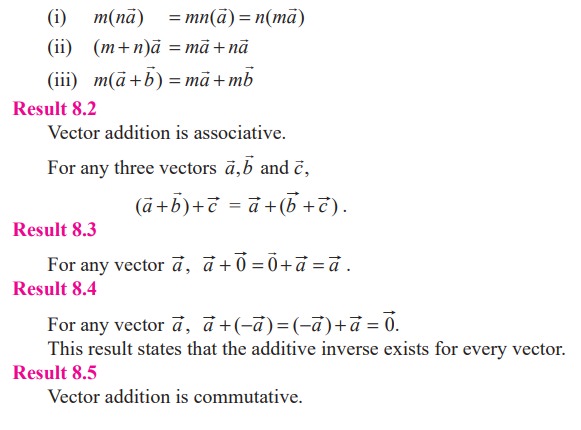
Proof
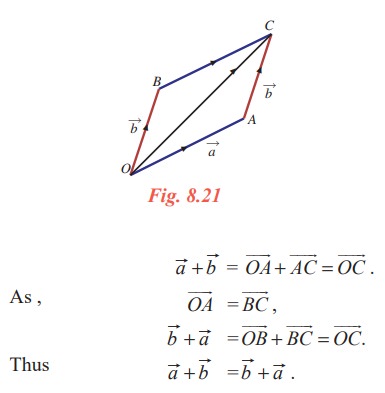
Polygon law of addition
 be any five vectors as shown in the Fig. 8.22.
be any five vectors as shown in the Fig. 8.22.We observe from the figure that each vector is drawn E from the terminal point of its previous one. By the triangle law,
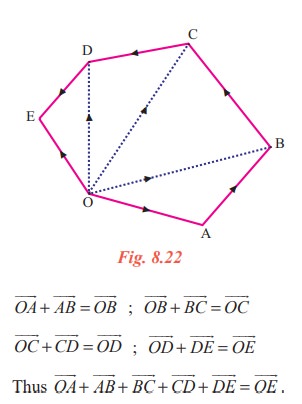
Thus the line joining the initial point of first vector to the terminal point at the last vector is the sum of all the vectors. This is called the polygon law of addition of vectors.
Example 8.1
Represent graphically the displacement of
(i) 30 km 60º west of north
(ii) 60 km 50º south of east.
Solution
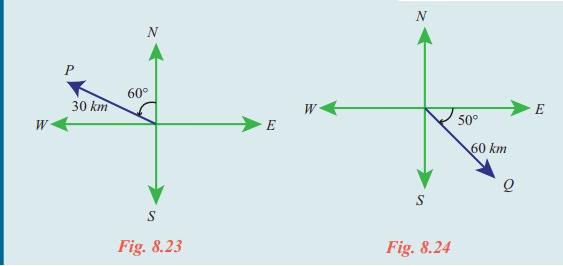
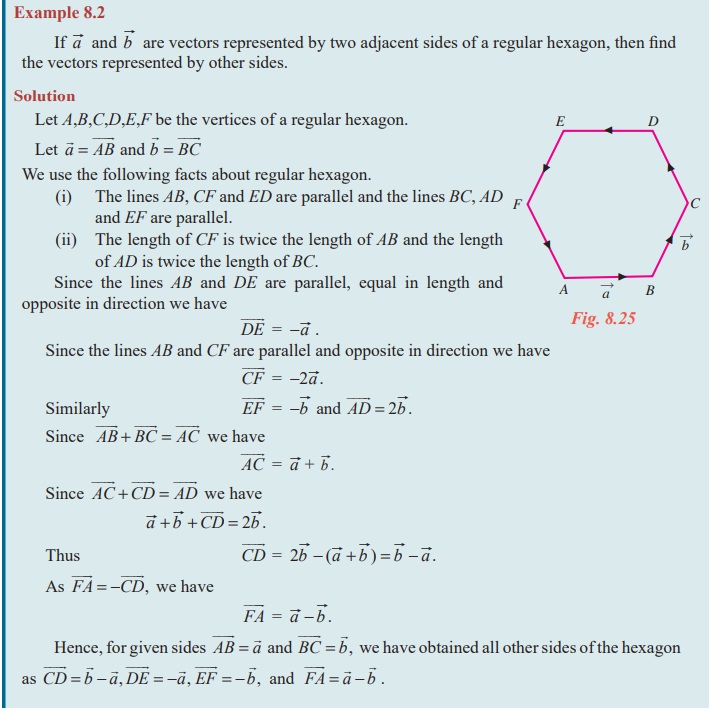
Related Topics